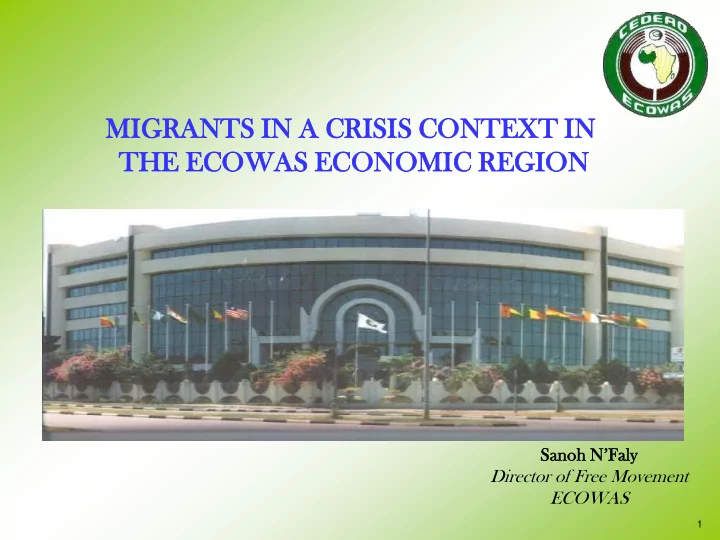

MIGRA RANT NTS S IN A CRISI SIS S CONTEXT IN THE ECOWAS S ECONOMIC C REGION Sanoh N’Faly Director of Free Movement ECOWAS 1
PLAN: INTRODUCTION ANALYSIS OF MIGRATORY CRISES LESSONS LEARNED CONCLUSIONS 2
INTRODUCTION ECOWAS has traditionally been a vast migratory space impacted by three phenomena: Poverty; Socio-political crises; Facilitation of entry into the region due to the protocol on the free movement of persons, right of residency and establishment of the ECOWAS. Two populous ethnic groups share this 15,000 km space: • The Hausa, numbering 30 million; • The Mandingo, numbering 15 million. The mobility of migrants within ECOWAS constitutes a significant risk for the economies and the political stability of the member States. By their nature they are long, temporary, cyclical, internal and intra-regional. 3
THE MIGRATORY CRISES The ECOWAS economic space has polarised the attention of the international community over the last few years. The political-military, environmental and economic crises determine the cycles of migrants. The first armed conflicts to have broken out in Liberia and Sierra Leone led to the massive flight of their populations to the neighbouring countries, Guinea and Ivory Coast. Due to such large-scale crisis, millions of refugees in certain ECOWAS countries are actively looking for local integration. 4
THE CASE OF IVORY COAST The Ivory Coast is by far the largest country of immigration of ECOWAS. The 2002 crisis had a regional dimension to it. It led to the redistribution of the population throughout all of the neighbouring countries. Burkinabes, Guineans, Malians, Senegalese, Nigerians withdrew, but not for long. In 2006, there were 610,800 returnees. This number should increase in the aftermath of the post-electoral crisis. Moreover, the progressive return of political stability and the spurt of economic growth has attracted more and more West Africans and other foreigners as well. 5
THE CASE OF THE SAHEL The geographic location of the Sahel makes it an excellent observatory. NIGER, country of transitory immigration The politic factor Armed conflicts in Ivory Coast and in Libya led to an increase in 2011, 2012 and in 2013 of migrants returning to Nigeria and Central Africa, numbering 429,231 With the intensification of attacks committed by the Islamic sect Boko Haram and the fighting launched against it by the Nigerian army, many Nigerians have been expelled from Nigeria because they allegedly belonged to the sect. The break-out of war in Northern Mali caused an influx of 50,000 refugees. 6
THE CASE OF THE SAHEL (continued) The economic factor Food insecurity Ever since the 1960s, the economy of Niger is characterised by years of surpluses and years of deficit. The deficit years mostly win out over the other years. Of the 36 Departments constituting the country, 16 (or 44%) experience food insecurity on a permanent basis. The persistence of food insecurity is largely the cause of many of the migration fluxes, both as internal displacements as well as towards neighbouring countries. 7
MALI Mali experienced troubles in early 2012 whose aggravated causes were armed conflict and permanent insecurity. This situation led to a wide-scale migratory crisis. In April 2013, there were around 301,027 displaced people within the country; In May 2013, there were around185,144 people who crossed over the Malian borders, including 176,144 refugees. Food insecurity As in Niger, the deep drought of 2011/2012 and bad harvests placed approximately 4 million people in a situation of food insecurity. 8
MALI (continued) The Algerian border was closed on January 14th 2013, shutting down an important commercial corridor in the North, which affected the region proportionally: A lack of basic supplies (flour, milk, oil and sugar), followed by price increases, made most foodstuffs unaffordable for the population which had stayed behind, and eventually pushed them to leave towards neighbouring countries. 9
LESSONS LEARNED The political-military crises and the existence of an austere environmental landscape which suffered the instabilities of climate hazard effects are the elements which led to migratory crises in the ECOWAS region. The crises have revealed the phenomena of circular migration between the affected host countries and the countries of origin of the migrants, thus the phenomenon known as migratomania . Why such massive returns to host countries that are themselves in crisis? The resistance to the migrants' reintegration in economic activities. No decent employment barring the path to self-sufficiency; Insufficient material and financial support to encourage a sustainable return. No national or regional coordination mechanisms for migration in the period preceding the crisis (the IOM, HCR, OCHA and ECOWAS) do 10 not have any common action mechanism.
LESSONS (continued) ECOWAS does not have a monitoring and warning system for cross- border migratory flows in case of crisis. There is no communication system among the actors concerned by migration through the NTICs. 11
CONCLUSIONS A regional approach to migratory crises must be implemented in order to better respond to security economic, social and political challenges and risks raised by the migratory crises in the ECOWAS region. The following measures should be adopted: Implementation of a framework for dialogue between the international institutions active in the area of migration, and humanitarian operations, ECOWAS and national organizations. Provide ECOWAS with a monitoring and warning system for cross-border migratory flows in case of crisis. 12
THANK YOU MERCI OBRIGADO 13
Recommend
More recommend